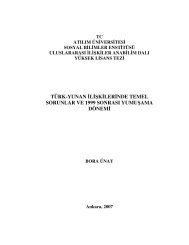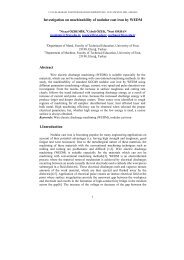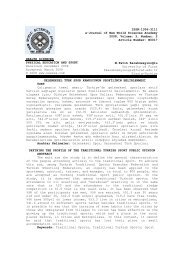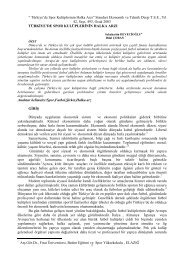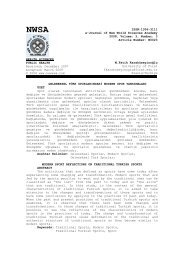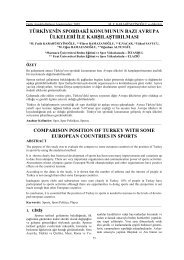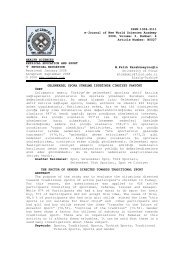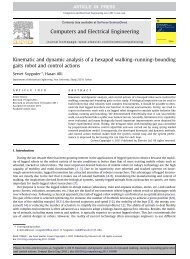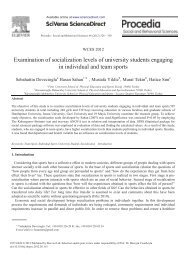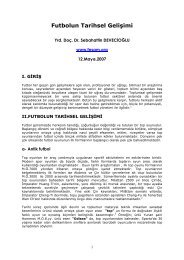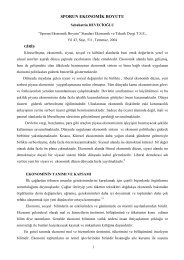Journal of Coordination Chemistry
Journal of Coordination Chemistry
Journal of Coordination Chemistry
Create successful ePaper yourself
Turn your PDF publications into a flip-book with our unique Google optimized e-Paper software.
This article was downloaded by:[ANKOS 2007 ORDER Consortium]<br />
On: 3 December 2007<br />
Access Details: [subscription number 772815469]<br />
Publisher: Taylor & Francis<br />
Informa Ltd Registered in England and Wales Registered Number: 1072954<br />
Registered <strong>of</strong>fice: Mortimer House, 37-41 Mortimer Street, London W1T 3JH, UK<br />
<strong>Journal</strong> <strong>of</strong> <strong>Coordination</strong> <strong>Chemistry</strong><br />
Publication details, including instructions for authors and subscription information:<br />
http://www.informaworld.com/smpp/title~content=t713455674<br />
Studies on mononuclear chelates derived from<br />
substituted Schiff-base ligands (part 6): synthesis and<br />
characterization <strong>of</strong> a new<br />
3-ethoxysalicyliden-p-aminoacetophenoneoxime and its<br />
complexes with cobalt(II), nickel(II), copper(II) and<br />
zinc(II)<br />
Erdal Canpolat a ; Mehmet Kaya b ; Ömer Faruk Öztürk c<br />
a Faculty <strong>of</strong> Education, Department <strong>of</strong> Science and Mathematics for Secondary<br />
Education, University <strong>of</strong> Firat, Elaz , Turkey<br />
b Faculty <strong>of</strong> Arts and Sciences, Department <strong>of</strong> <strong>Chemistry</strong>, University <strong>of</strong> Firat,<br />
Elaz , Turkey<br />
c Faculty <strong>of</strong> Arts and Sciences, Department <strong>of</strong> <strong>Chemistry</strong>, University <strong>of</strong> Onsekiz Mart, Çanakkale, Turkey<br />
First Published on: 18 June 2007<br />
To cite this Article: Canpolat, Erdal, Kaya, Mehmet and Öztürk, Ömer Faruk (2007) 'Studies on mononuclear chelates<br />
derived from substituted Schiff-base ligands (part 6): synthesis and characterization <strong>of</strong> a new<br />
3-ethoxysalicyliden-p-aminoacetophenoneoxime and its complexes with cobalt(II), nickel(II), copper(II) and zinc(II)',<br />
<strong>Journal</strong> <strong>of</strong> <strong>Coordination</strong> <strong>Chemistry</strong>, 60:23, 2621 - 2627<br />
To link to this article: DOI: 10.1080/00958970701286458<br />
URL: http://dx.doi.org/10.1080/00958970701286458<br />
PLEASE SCROLL DOWN FOR ARTICLE<br />
Full terms and conditions <strong>of</strong> use: http://www.informaworld.com/terms-and-conditions-<strong>of</strong>-access.pdf<br />
This article maybe used for research, teaching and private study purposes. Any substantial or systematic reproduction,<br />
re-distribution, re-selling, loan or sub-licensing, systematic supply or distribution in any form to anyone is expressly<br />
forbidden.<br />
The publisher does not give any warranty express or implied or make any representation that the contents will be<br />
complete or accurate or up to date. The accuracy <strong>of</strong> any instructions, formulae and drug doses should be<br />
independently verified with primary sources. The publisher shall not be liable for any loss, actions, claims, proceedings,<br />
demand or costs or damages whatsoever or howsoever caused arising directly or indirectly in connection with or<br />
arising out <strong>of</strong> the use <strong>of</strong> this material.
Downloaded By: [ANKOS 2007 ORDER Consortium] At: 10:38 3 December 2007<br />
<strong>Journal</strong> <strong>of</strong> <strong>Coordination</strong> <strong>Chemistry</strong><br />
Vol. 60, No. 23, 1 December 2007, 2621–2627<br />
Studies on mononuclear chelates derived from substituted<br />
Schiff-base ligands (part 6): synthesis and characterization<br />
<strong>of</strong> a new 3-ethoxysalicyliden-p-aminoacetophenoneoxime<br />
and its complexes with cobalt(II), nickel(II),<br />
copper(II) and zinc(II)<br />
ERDAL CANPOLAT*y, MEHMET KAYAz and<br />
ÖMER FARUK O¨ ZTU¨ RKx<br />
yFaculty <strong>of</strong> Education, Department <strong>of</strong> Science and Mathematics for<br />
Secondary Education, University <strong>of</strong> Firat, 23119, Elaz|g˘, Turkey<br />
zFaculty <strong>of</strong> Arts and Sciences, Department <strong>of</strong> <strong>Chemistry</strong>,<br />
University <strong>of</strong> Firat, 23119, Elaz|g˘, Turkey<br />
xFaculty <strong>of</strong> Arts and Sciences, Department <strong>of</strong> <strong>Chemistry</strong>,<br />
University <strong>of</strong> Onsekiz Mart, 17100, C¸anakkale, Turkey<br />
(Received 27 June 2006; in final form 21 September 2006)<br />
Schiff-base complexes <strong>of</strong> cobalt(II), nickel(II), copper(II) and, zinc(II) with 3-ethoxysalicylidenp-aminoacetophenoneoxime<br />
(HL) were prepared and characterized on the basis <strong>of</strong> elemental<br />
analyses, IR, 1 H- and 13 C-NMR, electronic spectra, magnetic susceptibility measurements,<br />
molar conductivity and thermogravimetric analyses (TGA). A tetrahedral geometry has been<br />
assigned to the complexes.<br />
Keywords: Schiff bases; Cobalt(II); Nickel(II); Copper(II); Zinc(II) complexes<br />
1. Introduction<br />
Among the variety <strong>of</strong> ligand systems [1–5], Schiff bases are an important class having<br />
many applications [6] and many complexes <strong>of</strong> different Schiff bases have been reported<br />
by a number <strong>of</strong> authors [7, 8]. Schiff-base complexes have a wide variety <strong>of</strong> structures,<br />
coordinating to metal in either mono- or bidentate modes, depending upon the<br />
aldehyde and amines [9]. Unsymmetrical Schiff-base ligand complexes have been<br />
suggested as useful biological models in understanding irregular binding <strong>of</strong> peptides [10]<br />
and also as catalysts in some chemical processes [11]. The presence <strong>of</strong> transition metals<br />
in human blood plasma indicates their importance in the mechanism for accumulation,<br />
storage and transport <strong>of</strong> transition metals in living organisms [12]. In the present article,<br />
we report the synthesis and characterization <strong>of</strong> a new Schiff-base ligand and its<br />
complexes with cobalt(II), nickel(II), copper(II) and, zinc(II) ions.<br />
*Corresponding author. Email: ecanpolat@firat.edu.tr<br />
<strong>Journal</strong> <strong>of</strong> <strong>Coordination</strong> <strong>Chemistry</strong><br />
ISSN 0095-8972 print/ISSN 1029-0389 online ß 2007 Taylor & Francis<br />
DOI: 10.1080/00958970701286458
Downloaded By: [ANKOS 2007 ORDER Consortium] At: 10:38 3 December 2007<br />
2622 E. Canpolat et al.<br />
2. Experimental<br />
Elemental analyses (C, H, N) were carried out using LECO-932 CHNSO by the<br />
Technical and Scientific Research Council <strong>of</strong> Turkey, TUBITAK. IR spectra were<br />
recorded on a Mattson 1000 FT-IR Spectrometer as KBr pellets. 1 H- and 13 C-NMR<br />
spectra were recorded on a Bruker GmbH Dpx-400 MHz High Performance Digital FT–<br />
NMR Spectrometer. Electronic spectra were obtained on a Shimadzu 1240 UV<br />
Spectrometer at Hacettepe University. Magnetic susceptibilities were determined on a<br />
Sherwood Scientific Magnetic Susceptibility Balance (Model MK1) at room temperature<br />
using Hg[Co(SCN)4] as a calibrant; diamagnetic corrections were calculated from<br />
Pascal’s constants. Melting points were determined on a Gallenkamp melting point<br />
apparatus. Molar conductances <strong>of</strong> the Schiff-base ligand and its transition metal<br />
complexes were determined at room temperature using a CMD 750 WPA conductivity<br />
meter. TGA curves were recorded on a Shimadzu TG-50 thermo balance.<br />
2.1. 3-Ethoxysalicyliden-p-aminoacetophenoneoxime (LH)<br />
To a solution <strong>of</strong> (1.502 g, 10 mmol) p-aminoacetophenoneoxime [13] in 15 mL absolute<br />
EtOH, 3-ethoxysalicylaldehyde (1.662 g, 10 mmol) and (0.01 mg) p-toluene sulfonic acid<br />
dissolved in 20 mL absolute EtOH was added dropwise at 60 C with continuous stirring<br />
and monitoring <strong>of</strong> the course <strong>of</strong> the reaction with IR. The precipitate was filtered,<br />
washed with cold EtOH and Et2O several times and crystallized from acetone–water<br />
and dried at 60 C to constant weight.<br />
2.2. Bis(p-aminoacetophenoneoxime-3-ethoxysalicylaldiminato)cobalt(II) CoL2<br />
A solution <strong>of</strong> Co(AcO)2 4H2O (0.125 g, 0.50 mmol) in absolute EtOH (15 mL) was<br />
added to a hot (50 C) solution <strong>of</strong> HL (0.298 g, 1.00 mmol) in absolute EtOH (20 mL)<br />
under an argon atmosphere. The complex was obtained immediately upon addition <strong>of</strong><br />
the metal salt solution. The precipitated complex was filtered <strong>of</strong>f, washed with H2O,<br />
cold EtOH and cold Et2O several times and dried in vacuo.<br />
2.3. Bis(p-aminoacetophenoneoxime-3-ethoxysalicylaldiminato)nickel(II) NiL2<br />
NiL 2 was prepared following the same procedure as described for Co(L) 2, starting<br />
from HL (0.298 g, 1.00 mmol) and Ni(AcO) 2 4H 2O (0.124 g, 0.50 mmol).<br />
2.4. Bis(p-aminoacetophenoneoxime-3-ethoxysalicylaldiminato)copper(II) CuL2<br />
CuL 2 was prepared following the same procedure as described for Co(L) 2, starting<br />
from HL (0.298 g, 1.00 mmol) and Cu(AcO)2 H2O (0.100 g, 0.50 mmol).<br />
2.5. Bis(p-aminoacetophenoneoxime-3-ethoxysalicylaldiminato)zinc(II) ZnL2<br />
ZnL2 was prepared following the same procedure as described for Co(L)2, starting<br />
from HL (0.298 g, 1.00 mmol) and Zn(AcO)2 2H2O (0.110 g, 0.50 mmol).
Downloaded By: [ANKOS 2007 ORDER Consortium] At: 10:38 3 December 2007<br />
3. Results and discussion<br />
The ligand (LH) was prepared by reacting equimolar amounts <strong>of</strong> 3-ethoxysalicylaldehyde<br />
with p-aminoacetophenoneoxime in absolute ethanol (scheme 1). Structures <strong>of</strong><br />
the ligand and complexes were established with the use <strong>of</strong> IR, 1 H- and 13 C-NMR<br />
spectra, elemental analyses, UV, magnetic susceptibility measurements and thermogravimetric<br />
analyses (tables 1–5).<br />
Reactions <strong>of</strong> the Schiff-base ligand with the corresponding metal salt may be<br />
represented by the follows:<br />
H 5 C 2 O<br />
2HL þ CoðCH3COOÞ2 4H2O ! CoL2 þ 2CH3COOH þ 4H2O<br />
2HL þ NiðCH3COOÞ2 4H2O ! NiL2 þ 2CH3COOH þ 4H2O<br />
2HL þ CuðCH3COOÞ2 H2O ! CuL2 þ 2CH3COOH þ H2O<br />
2HL þ ZnðCH3COOÞ2 2H2O ! ZnL2 þ 2CH3COOH þ 2H2O<br />
Table 1. Analytical and physical data <strong>of</strong> the ligand and the complexes.<br />
Elemental analysis<br />
Calculated (found) (%)<br />
Compounds<br />
Formula<br />
(Fw) g mol 1<br />
Color M.p. ( C) Yield (%) C H N<br />
HL C17H18N2O3<br />
(298.34)<br />
Dark orange 152 77 68.44<br />
(68.07)<br />
6.08<br />
(5.72)<br />
9.39<br />
(8.99)<br />
CoL2 CoC34H34N4O6 (653.59)<br />
Light red 145 64 62.48<br />
(62.81)<br />
5.24<br />
(4.87)<br />
8.57<br />
(8.90)<br />
NiL2 NiC34H34N4O6<br />
(653.35)<br />
Light green 247 61 62.50<br />
(62.79)<br />
5.25<br />
(4.95)<br />
8.58<br />
(8.86)<br />
CuL2 CuC34H34N4O6<br />
(658.20)<br />
Dark green 4300 68 62.04<br />
(61.72)<br />
5.21<br />
(5.60)<br />
8.51<br />
(8.32)<br />
ZnL2 ZnC34H34N4O6 (660.05)<br />
Dark yellow 4300 62 61.87<br />
(62.20)<br />
5.19<br />
(4.81)<br />
8.49<br />
(8.18)<br />
Compounds<br />
New 3-ethoxysalicyliden-p-aminoacetophenoneoxime and its complexes 2623<br />
OH<br />
O<br />
Table 2. Characteristic IR bands <strong>of</strong> the ligand and the complexes (cm 1 ).<br />
(O–H)<br />
oxime<br />
H 2 N<br />
(O–H)<br />
phenolic<br />
(C¼N)<br />
azomethine<br />
(C¼N)<br />
oxime (C–O) (N–O)<br />
HL 3430s 3238s 1617vs 1594s 1257s 1004w<br />
CoL2 3427s – 1610vs 1594s 1272m 1004w<br />
NiL2 3429s – 1609vs 1594s 1275m 1007w<br />
CuL2 3430s – 1610vs 1594s 1267m 1011w<br />
ZnL 2 3430s – 1605vs 1590s 1270m 1007w<br />
Note: m, medium; s, strong; vs, very strong; w, weak.<br />
+<br />
CH 3<br />
N<br />
OH<br />
Abs. EtOH<br />
–H 2 O<br />
13<br />
H 5 C 2 O<br />
Scheme 1. Structure <strong>of</strong> the ligand.<br />
12<br />
14<br />
11<br />
10<br />
15<br />
OH a<br />
9<br />
N<br />
HL<br />
5<br />
4<br />
6 3<br />
7<br />
8<br />
OH b<br />
CH3 1<br />
2<br />
N
Downloaded By: [ANKOS 2007 ORDER Consortium] At: 10:38 3 December 2007<br />
2624 E. Canpolat et al.<br />
Table 3.<br />
1 H- and 13 C-NMR spectral data <strong>of</strong> the ligand and the zinc(II) complex (ppm).<br />
Compounds<br />
HL 1.36(s, 3H, H1), 2.15(t, 3H, H17), 4.04(d, 2H, H16), 6.79–7.65(m, 7H,<br />
Ar–H), 8.69(s, 1H, H9),<br />
10.88(s, 1H, H b ), 13.50(s, 1H, H a )<br />
ZnL 2<br />
1.38(s, 6H, H 1), 2.13(t, 6H, H 17),<br />
4.06(d, 4H, H16), 6.94–7.64(m,<br />
14H, Ar–H), 8.55(s, 2H, H 9),<br />
10.90(s, 2H, H b )<br />
s: singlet, d: dublet, t ¼ triplet, m: multiplet.<br />
Table 5. TGA data <strong>of</strong> the complexes.<br />
Decomposition temperature<br />
(%) Calculated (found)<br />
Compounds First step Second step<br />
10.85(–CH 3), 14.16 and 63.72(–OC 2H 5),<br />
115.97–135.29(Ar–C), 118.42(*C–CH¼N),<br />
146.64(C¼NOH), 147.03(C–O–C2H5),<br />
150.75(C–OH), 152.04(CH¼N–C*),<br />
162.09(CH¼N)<br />
11.02(–CH 3), 14.47 and 63.98(–OC 2H 5),<br />
116.06–135.55(Ar–C), (*C–CH¼N),<br />
146.26(C¼NOH), 147.03(C–O–C 2H 5),<br />
152.13(C–OH), 153.21(CH¼N–C*),<br />
165.32(CH¼N)<br />
Table 4. Magnetic moment, molar conductance, and electronic spectral data <strong>of</strong> the ligand and the<br />
complexes.<br />
max, nm(", L mol 1 cm 1 )<br />
Compounds eff, B M (<br />
1 2 1<br />
cm mol ) d–d C–T n ! * azomethine<br />
HL – 1.9 – – 378(2.06 10 3 )<br />
CoL2 4.18 3.4 660(191) 431(2.07 10 3 ) 370(3.95 10 3 NiL2 2.99 2.7 620(162) 417(2.80 10<br />
)<br />
3 ) 362(1.50 10 3 CuL2 1.87 3.6 553(160) 425(2.27 10<br />
)<br />
3 ) 384(2.83 10 3)<br />
ZnL2 Dia 4.0 – 419(3.00 10 3 ) 387(2.50 10 3 )<br />
Weight loss (%)<br />
Calculated (found)<br />
Residue (%)<br />
Calculated (found)<br />
CoL2 155–258 258–493<br />
20.20(21.79) 68.34(66.17) 88.54(87.96) 11.46(12.04)<br />
NiL 2 211–282 282–482<br />
20.21(19.24) 68.36(68.65) 88.57(87.89) 11.43(12.11)<br />
CuL 2 197–261 261–394<br />
11.85(12.39) 76.07(74.49) 87.92(86.88) 12.08(13.12)<br />
ZnL2 144–187 187–463<br />
20.00(21.63) 67.67(66.58) 87.67(88.21) 12.33(11.79)<br />
The analytical and physical data given in table 1 for the ligand and its complexes are in<br />
good agreement with the formulae proposed.<br />
The characteristic infrared frequencies (as KBr pellets) for all the complexes and the<br />
ligand listed are given in table 2. The ligand contains four potential donor sites: (1) the<br />
phenolic oxygen, (2) the azomethine nitrogen, (3) the oxime oxygen, and (4) the oxime<br />
nitrogen. The O–H (phenolic) absorption observed at 3238 cm 1 in the free Schiff base<br />
is absent in the complexes, indicating deprotonation occurs prior to the coordination<br />
through the oxygen atom. A strong band was observed at 1617 cm 1 in the free ligand,<br />
characteristic <strong>of</strong> the C¼N (azomethine) group. It is expected that coordination <strong>of</strong> the
Downloaded By: [ANKOS 2007 ORDER Consortium] At: 10:38 3 December 2007<br />
New 3-ethoxysalicyliden-p-aminoacetophenoneoxime and its complexes 2625<br />
nitrogen to the metal would reduce the electron density in the azomethine link and thus,<br />
lower the C¼N stretching frequency. In the complexes the frequency was observed in<br />
the region 1605–1610 cm 1 , indicating coordination <strong>of</strong> the Schiff base through the<br />
azomethine nitrogen [13–17]. The practically unchanged O–H (oxime) [18–20] at 3430<br />
and C¼N (oxime) [21–23] at 1594 cm 1 <strong>of</strong> the oxime group confirm that the oxime<br />
group itself does not coordinate to metal by oxygen or nitrogen [24].<br />
The 1 H- and 13 C-NMR spectra <strong>of</strong> the ligand and its zinc(II) complex were recorded<br />
in a mixture <strong>of</strong> CDCl3 and DMSO-d6; data are given in table 3. The H a signal at<br />
13.50 ppm disappeared upon addition <strong>of</strong> D2O to the solution, indicating that it is an<br />
acidic proton [25]. More detailed information about the structure <strong>of</strong> ligand was<br />
provided by 13 C-NMR spectral data. C15, C9 and C6 carbon atoms are observed at<br />
150.75, 162.09 and 152.04 ppm, respectively, for HL. The 1 H-NMR spectra <strong>of</strong> the<br />
zinc(II) complex shows no OH peaks, indicating coordination by phenolic oxygen to the<br />
metal ion after deprotonation [26]. The coordination <strong>of</strong> the azomethine nitrogen (H9) is inferred by upfield shift <strong>of</strong> H9 from 8.69 ppm in the ligand to 8.55 ppm in the<br />
complex [27]. In the 13 C-NMR spectrum <strong>of</strong> the zinc(II) complex C15, C9 and C6 carbon<br />
atoms are observed at 152.13, 165.32 and 153.21 ppm, respectively. The rest <strong>of</strong> the<br />
carbon atoms showed similar features for the free ligand and complex. The signals <strong>of</strong><br />
H b and C2 carbon (both in oxime) [28] are unchanged in the 1 H- and 13 C-NMR spectra<br />
<strong>of</strong> the complexes indicating that these oxime groups do not take part in complexation.<br />
The characteristic properties <strong>of</strong> the complexes and the Schiff base are shown in<br />
table 1. The elemental analysis results agree with the calculated values showing 1 : 2<br />
metal/ligand ratios.<br />
The electronic spectra <strong>of</strong> the ligand and all complexes were recorded in DMF at room<br />
temperature. The UV spectral data <strong>of</strong> the ligand and its complexes are given in table 4.<br />
The aromatic band <strong>of</strong> the ligand at 265 nm is attributed to benzene ! * transition.<br />
The band around 378 nm is due to the n ! * transition <strong>of</strong> the non-bonding electrons<br />
present on the nitrogen <strong>of</strong> the azomethine group in the Schiff base. Complexes <strong>of</strong><br />
cobalt(II), nickel(II) and copper(II) show less intense shoulders at ca 553–660 nm<br />
(" ¼ 160–191 L mol 1 cm 1 ), assigned as d–d transitions <strong>of</strong> the metal ions, due to the<br />
4<br />
A2 ! 4 T1 (P) for CoL2, 3 A2 ! 3 T2 (F) for NiL2 and 2 T2 ! 2 E (G) for CuL2 transitions<br />
<strong>of</strong> tetrahedral geometry. All the complexes show an intense band at ca 362–387 nm<br />
(" ¼ 1.50–3.95 10 3 L mol 1 cm 1 ) assigned to the n ! * transition associated<br />
with azomethine [29, 30]. The spectra <strong>of</strong> all the complexes show an intense band at<br />
ca 417–431 nm (" ¼ 2.07–3.00 10 3 L mol 1 cm 1 ), which can be assigned to charge<br />
transfer (C–T) transition <strong>of</strong> tetrahedral geometry [31–33].<br />
The magnetic moments for complexes have been measured at room temperature<br />
using a vibrating magnetometer with diamagnetic corrections applied. Effective<br />
magnetic moments <strong>of</strong> the complexes are shown in table 4. The cobalt(II), nickel(II)<br />
and copper(II) complexes are paramagnetic with magnetic moments <strong>of</strong> 4.18, 2.99 and<br />
1.87 BM, respectively. The zinc(II) complex is diamagnetic [34].<br />
The molar conductance <strong>of</strong> freshly prepared solutions <strong>of</strong> the complexes in 10 4 M<br />
DMSO solutions are observed in the range 2.7–4.0 (<br />
1 cm 2 mol 1 ) (table 4) indicating<br />
non-electrolytes [35] in table 4.<br />
The thermal behavior <strong>of</strong> the ligand and complexes has been investigated using<br />
thermogravimetric techniques. The thermogravimetric (TG), curves for the complexes<br />
were obtained at a heating rate <strong>of</strong> 10 C min 1 in 30 mL min 1 flowing nitrogen over<br />
a temperature range <strong>of</strong> 20–800 C. Approximately 10 mg samples <strong>of</strong> the complexes were
Downloaded By: [ANKOS 2007 ORDER Consortium] At: 10:38 3 December 2007<br />
2626 E. Canpolat et al.<br />
used in each case. Thermal stability data are listed in table 5. The decomposition<br />
temperature and the weight losses were calculated from TGA data. The ligand is<br />
stable up to 185 C and its decomposition starts at 185 C and is completed at 597 C.<br />
All the complexes and the ligand decompose in two steps at different temperature<br />
ranges. Thermogravimetric studies <strong>of</strong> all the complexes showed no weight loss up to<br />
144 C, indicating absence <strong>of</strong> water in the complexes. In all cases the final products are<br />
the metal oxides [36, 37]. In addition, the thermal stability <strong>of</strong> the complexes increases in<br />
the order: Cu5Zn5Ni5Co.<br />
4. Conclusion<br />
Our research group has been heavily engaged in the synthesis <strong>of</strong> novel substituted<br />
oximes and their Schiff-base derivatives; many Schiff-base derivatives containing<br />
substituted oxime, have been synthesized, characterized and used for complexation <strong>of</strong><br />
transition metals. Functional groups, such as oxime are very far from the pendants<br />
taking part in complexation and have no effect on the complexes. TGA and elemental<br />
analyses indicate no lattice/coordinated water molecules in the complexes. For these<br />
complexes, analytical and physical data in tables 1–5 suggest the complexes are<br />
tetrahedral. The suggested modes <strong>of</strong> coordination are shown in figure 1. All complexes<br />
are soluble in DMSO and DMF.<br />
Acknowledgement<br />
H 5 C 2 O<br />
N<br />
H 3 C<br />
OH<br />
O<br />
We thank Firat University Research Found for support (project no: FUBAP 835).<br />
N<br />
M<br />
N<br />
O<br />
ML 2<br />
M = Co II , Ni II , Cu II and Zn II<br />
HO<br />
CH 3<br />
N<br />
OC 2 H 5<br />
Figure 1. Suggested structure <strong>of</strong> the tetrahedral complexes.
Downloaded By: [ANKOS 2007 ORDER Consortium] At: 10:38 3 December 2007<br />
References<br />
New 3-ethoxysalicyliden-p-aminoacetophenoneoxime and its complexes 2627<br />
[1] A.D. Garnovskii, A.P. Sadimenko, M.I. Sadimenko, D.A. Garnovskii. Coord. Chem. Rev., 173,<br />
31 (1998).<br />
[2] G. Wilkinson. Comprehensive <strong>Coordination</strong> <strong>Chemistry</strong>, Pergamon Press, Oxford (1987).<br />
[3] S.V. Kawaguchi. <strong>Coordination</strong> Modes <strong>of</strong> Ligands in Metal Complexes, Springer, Berlin (1988).<br />
[4] A.D. Garnovskii. Coord. Chem., 14, 579 (1988).<br />
[5] A.D. Garnovskii, A.L. Nivorozhkin, V.I. Minkin. Coord. Chem. Rev., 126, 1 (1993).<br />
[6] K.M. Patel, K.N. Patel, N.H. Patel, M.N. Patel. Synth. React. Inorg. Met.-Org. Chem., 31, 239 (2001).<br />
[7] M.S. Islam, M.A. Farooque, M.A.K. Bodruddoza. Synth. React. Inorg. Met.-Org. Chem., 32, 1811<br />
(2001).<br />
[8] G.B. Wang, J.C. Chang. Synth. React. Inorg. Met.-Org. Chem., 21, 897 (1991).<br />
[9] L.A. Zyzyck, H. Frummer, J.F. Villa. J. Inorg. Nucl. Chem., 37, 1653 (1975).<br />
[10] R. Atkins, G. Brewer, E. Kokot, G.M. Mockler, E. Sinn. Inorg. Chem., 24, 127 (1985).<br />
[11] D.M. Boghaei, S. Mohebi. Tetrahedron, 58, 5357 (2002).<br />
[12] J.D. Joshi, S. Sharma, G. Patel, J.J. Vora. Synth. React. Inorg. Met.-Org. Chem., 32, 1729 (2002).<br />
[13] E. Canpolat, M. Kaya. Polish J. Chem., 79, 959 (2005).<br />
[14] E. Canpolat. Polish J. Chem., 79, 619 (2005).<br />
[15] E. Canpolat, M. Kaya, A. Yaz|c|. Spectros. Lett., 38, 35 (2005).<br />
[16] T.D. Thangadurai, M. Gowri, K. Natarajan. Synth. React. Inorg. Met.-Org. Chem., 32, 329 (2002).<br />
[17] H.A. Patwardhan, S. Gopinathan, C. Gopinathan. Indian J. Chem. Sec. A, 16, 224 (1978).<br />
[18] E. Canpolat, M. Kaya. J. Coord. Chem., 58, 1217 (2005).<br />
[19] E. Canpolat, M. Kaya. Russian J. Chem., 31, 415 (2005).<br />
[20] S. Tuna, E. Canpolat, M. Kaya. Polish J. Chem., 80, 227 (2006).<br />
[21] E. Canpolat, M. Kaya. J. Coord. Chem., 58, 1063 (2005).<br />
[22] E. Canpolat, M. Kaya. Turkish J. Chem., 29, 409 (2005).<br />
[23] E. Canpolat, M. Kaya. Russian J. Coord. Chem., 31, 415 (2005).<br />
[24] E. Canpolat, M. Kaya. Russian J. Chem., 31, 790 (2005).<br />
[25] E.W. Opozda, W. Lasocha, B. Wlodarczyk-Gajda. Z. Anorg. Allg. Chem., 630, 597 (2004).<br />
[26] B.V. Agarwala, S. Hingorani, V. Puri, C.L. Khetrapal, G.A. Naganagowda. Trans. Met. Chem., 19,<br />
1 (1994).<br />
[27] H.R. Singh, B.V. Agarwala. J. Indian Chem. Soc., 65, 591 (1988).<br />
[28] E. Canpolat, M. Kaya. Trans. Met. Chem., 29, 550 (2004).<br />
[29] J.C. Rasmussen, H. T<strong>of</strong>tlund, A.N. Nivorzhkin, J. Bourassa, P.C. Ford. Inorg. Chim. Acta, 251,<br />
291 (1996).<br />
[30] S. Yamada, A. Takeuchi. Coord. Chem. Rev., 43, 187 (1982).<br />
[31] A.B.P. Lever. Inorganic Electronic Spectroscopy, 2nd Edn, Elsevier, Amsterdam (1997).<br />
[32] M.R. Wagner, F.A. Walker. Inorg. Chem., 22, 3021 (1983).<br />
[33] F.A. Cotton, G. Wilkinson. Advanced Inorganic <strong>Chemistry</strong>, Wiley, New York (1988).<br />
[34] M.M. Aboaly, M.M.H. Khalil. Spectros. Lett., 34, 495 (2001).<br />
[35] W.J. Geary. Coord. Chem. Rev., 7, 8 (1971).<br />
[36] M.I. Dhar, O. Singh. Thermochim. Acta, 191, 285 (1991).<br />
[37] E. Dubler, G. Hanggi. Thermochim. Acta, 234, 201 (1994).



